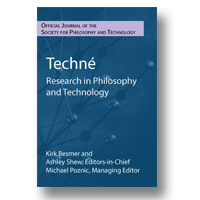|
|
|
1.
|
Techné: Research in Philosophy and Technology:
Volume >
20 >
Issue: 3
Christine Boshuijzen-van Burken
Beyond Technological Mediation:
A Normative Practice Approach
abstract |
view |
rights & permissions
| cited by
Several philosophers of technology have argued that technology mediates human actions. For example, in the branch of post-phenomenology, authors such as Don Ihde and Peter-Paul Verbeek have described the mediating aspects of technology in terms of morality of technology (more prominent in Verbeek) as well as in the sense that technology changes our perception of ourselves and the world (more prominent in Ihde). In this article, different existing types of mediation are presented, critiqued, and enriched. The four types are illustrated by referring to military high-tech environments with a focus on visual data and imaging technologies. These technologies can mediate actions (1) by inviting certain behavior, (2) through amplification and reduction, (3) through built-in norms, and (4) through interpretation. The four types of mediation mainly focus on the technology or technological artifact itself. What these approaches fail to grasp, however, is the specific user practices in which most technologies function. In this article, it is argued that to understand the mediating aspects of technology more fully, attention should be paid to the specific user context in which the technology functions. Therefore, an enriched understanding of the four types of mediation of technology is proposed by taking the lens of normative practices and analyzing the different types of mediation through this lens. The Kunduz airstrike incident, which took place in 2009 in Afghanistan, is a case in which a visual data sharing device called Rover played a prominent role. This case is used in this article to illustrate how technology mediates human actions in military practice.
|
|
|
|
|
|
|
2.
|
Techné: Research in Philosophy and Technology:
Volume >
20 >
Issue: 3
Chrysanthos Voutounos, Andreas Lanitis
A Cultural Semiotic Aesthetic Approach for a Virtual Heritage Project:
Part A—The Semiotic Foundations of the Approach
abstract |
view |
rights & permissions
| cited by
This paper presents an integrated framework applied towards the design and evaluation of a virtual museum of Byzantine art that combines the theorized fields of semiotics, virtual heritage (VH), and Byzantine art. A devised semiotic model, the case study semiosphere, synthesizes important principles from the theoretical background justifying the overall design and evaluation methodology. The approach presented has theoretical extensions to the understanding of the role technology plays in promoting a consummatory aesthetic experience for Byzantine art in virtual environments, complementing the experience received from traditional Byzantine art media. Part A of the work presents the development of the semiotic foundation of the study prior to presenting the applied potential of the approach in design and evaluation of VH for Byzantine art, which appears in Part B. The final task of the proposed approach aims to support a meaningful interpretation, assisting in the promotion of the significance (value) of the virtual museum to potential interpreters/visitors.
|
|
|
|
|
|
|
3.
|
Techné: Research in Philosophy and Technology:
Volume >
20 >
Issue: 3
Daniel Susser
Information Privacy and Social Self-Authorship
abstract |
view |
rights & permissions
| cited by
The dominant approach in privacy theory defines information privacy as some form of control over personal information. In this essay, I argue that the control approach is mistaken, but for different reasons than those offered by its other critics. I claim that information privacy involves the drawing of epistemic boundaries—boundaries between what others should and shouldn’t know about us. While controlling what information others have about us is one strategy we use to draw such boundaries, it is not the only one. We conceal information about ourselves and we reveal it. And since the meaning of information is not self-evident, we also work to shape how others contextualize and interpret the information that they have about us. Information privacy is thus about more than controlling information; it involves the constant work of producing and managing public identities, what I call “social self-authorship.” In the second part of the essay, I argue that thinking about information privacy in these terms reveals threats to privacy that the control approach neglects. Namely, information technology makes social self-authorship invisible and unnecessary by making it difficult for us to know when others are forming impressions about us and by providing others with tools for making assumptions about who we are which obviate the need for our involvement in the process.
|
|
|
|
|
|
|
4.
|
Techné: Research in Philosophy and Technology:
Volume >
20 >
Issue: 3
Stevens F. Wandmacher
The Bright Line of Ethical Agency
abstract |
view |
rights & permissions
| cited by
In his article The Nature, Importance, and Difficulty of Machine Ethics, James H. Moor distinguishes two lines of argument for those who wish to draw a “bright line” between full ethical agents, such as human beings, and “weaker” ethical agents, such as machines whose actions have significant moral ramifications. The first line of argument is that only full ethical agents are agents at all. The second is that no machine could have the presumed features necessary for ethical agency. This paper shows why Moor is mistaken in his refutation of the first line of argument; it also makes a positive case that “weaker” ethical agents are not agents at all. This positive case, however, allows Moor’s rejection of the second line of argument to stand: allowing that there could be moral machines, but that these machines would have to be full moral agents and not merely something that models moral behavior or can be used in morally charged ways.
|
|
|
|
|
|
|
5.
|
Techné: Research in Philosophy and Technology:
Volume >
20 >
Issue: 3
Maja Hojer Bruun
The Importance of Cultural Learning Processes for the Study of Technology
view |
rights & permissions
| cited by
|
|
|
|





